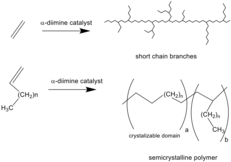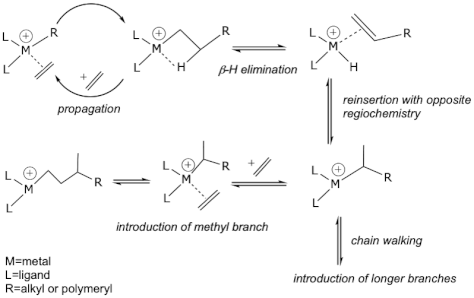Chain walking
In polymer chemistry, chain walking (CW) or chain running or chain migration is a mechanism that operates during some alkene polymerization reactions. CW can be also considered as a specific case of intermolecular chain transfer (analogous to radical ethene polymerization). This reaction gives rise to branched and hyperbranched/dendritic hydrocarbon polymers. This process is also characterized by accurate control of polymer architecture and topology.[1] The extent of CW, displayed in the number of branches formed and positions of branches on the polymers are controlled by the choice of a catalyst. The potential applications of polymers formed by this reaction are diverse, from drug delivery to phase transfer agents, nanomaterials, and catalysis.[2]
Catalysts
Catalysts that promote chain walking were discovered in the 1980-1990s. Nickel(II) and palladium(II) complexes of α-diimine ligands were known to efficiently catalyze polymerization of alkenes. They are also referred as Brookhart's catalysts after being used for making of high molar mass polyolefins for the first time at University of North Carolina at Chapel Hill in 1995.[3] Currently nickel and palladium complexes bearing α-diimine ligands, such as the two examples shown, are the most thoroughly described chain walking catalysts in scientific literature.[4] Ligand design influences not only CW extent but also regio- and stereoselectivity[5][6] and also the sensitivity of the catalyst to undergo chain-breaking reactions, mainly β-H elimination, influencing achievable molar mass and also the possibility to achieve living polymerization behaviour.[7][8][9][10][11] Thus stereo block copolymers could be made by combination of living and stereospecific CW polymerization catalysts.[6][12] Continuous research effort led to design of other ligands which provide CW polymerization catalysts upon complexation to late transition metals. Examples are β-diimine, α-keto-β-diimine,[13] amine-imine[14] and most recently diamine ligands.[15] As the vast majority of CW polymerization catalysts is based on late-transition metal complexes, having generally lower oxophilicity, these complexes were demonstrated also to provide copolymerisation of olefins with polar monomers like acrylates, alkylvinylketones, ω-alken-1-ols, ω-alken-1-carboxylic acids etc., which was the main initial intention of development of this class of catalysts.[16] These random copolymers could further be utilized in the construction of sophisticated amphiphilic grafted copolymers with hydrophobic polyolefin core and shell based on hydrophilic arms, in some cases made of stimuli-responsive polymers.[17]


Mechanism

CW occurs after the polymer chain has grown somewhat on the metal catalyst. The precursor is a 16 e− complex with the general formula [ML2(C2H4)(chain)]+. The ethylene ligand (the monomer) dissociates to produce a highly unsaturated 14 e− cation. This cation is stabilized by an agostic interaction. β-Hydride elimination then occurs to give a hydride-alkene complex. Subsequent reinsertion of the M-H into the C=C bond, but in the opposite sense gives a metal-alkyl complex.[18]

This process, a step in the chain walk, moves the metal from the end of a chain to a secondary carbon center. At this stage, two options are available: (1) chain walking can continue or (2) a molecule of ethylene can bind to reform the 16e complex. At this second resting state, the ethylene molecule can insert to grow the polymer or dissociate inducing further chain walking. If many branches can form, a hyperbranched topology results. Therefore, ethene only homopolymerization can provide branched polymer whereas the same mechanism leads to chain straightening in α-olefin polymerization.[16] The variation of CW by changing T, monomer concentration, or catalyst switch[19][20][21] can be used to produce block copolymer with amorphous and semi-crystalline blocks or with blocks of different topology.

References
- Guan, Z.; Cotts, PM; McCord, EF; McLain, SJ (1999). "Chain Walking: A New Strategy to Control Polymer Topology". Science. 283 (5410): 2059–2062. Bibcode:1999Sci...283.2059G. doi:10.1126/science.283.5410.2059. PMID 10092223.
- Guan, Z. (2010). "Recent Progress of Catalytic Polymerization for Controlling Polymer Topology". Chem. Asian J. 5 (5): 1058–1070. doi:10.1002/asia.200900749. PMID 20391469.
- Johnson, Lynda K.; Killian, Christopher M.; Brookhart, Maurice (June 1995). "New Pd(II)- and Ni(II)-Based Catalysts for Polymerization of Ethylene and .alpha.-Olefins". Journal of the American Chemical Society. 117 (23): 6414–6415. doi:10.1021/ja00128a054. ISSN 0002-7863.
- Domski, G. J.; Rose, J. M.; Coates, G. W.; Bolig, A. D.; Brookhart, M. (2007). "Living alkene polymerization: New methods for the precision synthesis of polyolefins". Prog. Polym. Sci. 32: 30–92. doi:10.1016/j.progpolymsci.2006.11.001.
- Cherian, Anna E.; Rose, Jeffrey M.; Lobkovsky, Emil B.; Coates, Geoffrey W. (October 2005). "A C 2 -Symmetric, Living α-Diimine Ni(II) Catalyst: Regioblock Copolymers from Propylene". Journal of the American Chemical Society. 127 (40): 13770–13771. doi:10.1021/ja0540021. ISSN 0002-7863.
- Rose, Jeffrey M.; Deplace, Fanny; Lynd, Nathaniel A.; Wang, Zhigang; Hotta, Atsushi; Lobkovsky, Emil B.; Kramer, Edward J.; Coates, Geoffrey W. (2008-12-23). "C 2 -Symmetric Ni(II) α-Diimines Featuring Cumyl-Derived Ligands: Synthesis of Improved Elastomeric Regioblock Polypropylenes". Macromolecules. 41 (24): 9548–9555. doi:10.1021/ma8019943. ISSN 0024-9297.
- Killian, Christopher M.; Tempel, Daniel J.; Johnson, Lynda K.; Brookhart, Maurice (January 1996). "Living Polymerization of α-Olefins Using Ni II −α-Diimine Catalysts. Synthesis of New Block Polymers Based on α-Olefins". Journal of the American Chemical Society. 118 (46): 11664–11665. doi:10.1021/ja962516h. ISSN 0002-7863.
- Gottfried, Amy C.; Brookhart, Maurice (February 2001). "Living Polymerization of Ethylene Using Pd(II) α-Diimine Catalysts". Macromolecules. 34 (5): 1140–1142. doi:10.1021/ma001595l. ISSN 0024-9297.
- Gottfried, Amy C.; Brookhart, M. (May 2003). "Living and Block Copolymerization of Ethylene and α-Olefins Using Palladium(II)−α-Diimine Catalysts". Macromolecules. 36 (9): 3085–3100. doi:10.1021/ma025902u. ISSN 0024-9297.
- Leone, Giuseppe; Mauri, Massimiliano; Bertini, Fabio; Canetti, Maurizio; Piovani, Daniele; Ricci, Giovanni (2015-03-10). "Ni(II) α-Diimine-Catalyzed α-Olefins Polymerization: Thermoplastic Elastomers of Block Copolymers". Macromolecules. 48 (5): 1304–1312. doi:10.1021/ma502427u. ISSN 0024-9297.
- Peleška, Jan; Hoštálek, Zdeněk; Hasalíková, Darja; Merna, Jan (January 2011). "Living/controlled hex-1-ene polymerization initiated by nickel diimine complexes activated by non-MAO cocatalysts: Kinetic and UV–vis study". Polymer. 52 (2): 275–281. doi:10.1016/j.polymer.2010.11.029.
- Sokolohorskyj, Anatolij; Železník, Ondřej; Císařová, Ivana; Lenz, Johannes; Lederer, Albena; Merna, Jan (2017-08-01). "α-keto-β-diimine nickel-catalyzed olefin polymerization: Effect of ortho-aryl substituents and preparation of stereoblock copolymers". Journal of Polymer Science Part A: Polymer Chemistry. 55 (15): 2440–2449. doi:10.1002/pola.28631.
- Azoulay, Jason D.; Rojas, Rene S.; Serrano, Abigail V.; Ohtaki, Hisashi; Galland, Griselda B.; Wu, Guang; Bazan, Guillermo C. (2009-01-26). "Nickel α-Keto-β-Diimine Initiators for Olefin Polymerization". Angewandte Chemie International Edition. 48 (6): 1089–1092. doi:10.1002/anie.200804661.
- Gao, Haiyang; Hu, Haibin; Zhu, Fangming; Wu, Qing (2012). "A thermally robust amine–imine nickel catalyst precursor for living polymerization of ethylene above room temperature". Chemical Communications. 48 (27): 3312. doi:10.1039/c2cc17154f. ISSN 1359-7345.
- Liao, Heng; Zhong, Liu; Xiao, Zefan; Zheng, Ting; Gao, Haiyang; Wu, Qing (2016-09-19). "α-Diamine Nickel Catalysts with Nonplanar Chelate Rings for Ethylene Polymerization". Chemistry - A European Journal. 22 (39): 14048–14055. doi:10.1002/chem.201602467.
- Ittel, Steven D.; Johnson, Lynda K.; Brookhart, Maurice (April 2000). "Late-Metal Catalysts for Ethylene Homo- and Copolymerization". Chemical Reviews. 100 (4): 1169–1204. doi:10.1021/cr9804644. ISSN 0009-2665.
- Chen, Yongsheng; Wang, Li; Yu, Haojie; Zhao, Yulai; Sun, Ruoli; Jing, Guanghui; Huang, Jin; Khalid, Hamad; Abbasi, Nasir M. (June 2015). "Synthesis and application of polyethylene-based functionalized hyperbranched polymers". Progress in Polymer Science. 45: 23–43. doi:10.1016/j.progpolymsci.2015.01.004.
- Atkins, P.; Overton, T.; Rourke, J.; Weller, M.; Armstrong, F.; Hagerman, M. (2010). Inorganic Chemistry (5th ed.). New York: W. H. Freeman and Company. p. 574. ISBN 978-0-19-923617-6.
- Mundil, Robert; Wilson, Lucy E.; Schaarschmidt, Dieter; Císařová, Ivana; Merna, Jan; Long, Nicholas J. (September 2019). "Redox-switchable α-diimine palladium catalysts for control of polyethylene topology". Polymer. 179: 121619. doi:10.1016/j.polymer.2019.121619.
- Anderson, W. Curtis; Rhinehart, Jennifer L.; Tennyson, Andrew G.; Long, Brian K. (2016-01-27). "Redox-Active Ligands: An Advanced Tool To Modulate Polyethylene Microstructure". Journal of the American Chemical Society. 138 (3): 774–777. doi:10.1021/jacs.5b12322. ISSN 0002-7863.
- Zhao, Minhui; Chen, Changle (2017-11-03). "Accessing Multiple Catalytically Active States in Redox-Controlled Olefin Polymerization". ACS Catalysis. 7 (11): 7490–7494. doi:10.1021/acscatal.7b02564. ISSN 2155-5435.